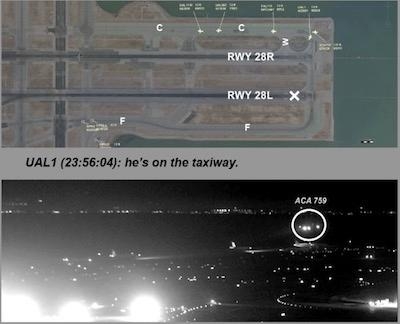Thu, Sep 27, 2018
Descended To An Altitude Of Just 100 Feet AGL Before Initiating Go-Around
The NTSB determined Tuesday an Air Canada flight crew’s lack of awareness caused the July 7, 2017, overflight of a taxiway at San Francisco International Airport (KSFO).

Air Canada flight 759 was cleared to land on runway 28R but instead lined up with parallel taxiway C where four airplanes were awaiting clearance to take off. Flight 759 descended to an altitude of 100 feet above ground level and overflew the first of the four airplanes. The flight crew initiated a go-around, and flight 759 reached a minimum altitude of about 60 feet above ground level and overflew the second airplane before starting to climb.
The NTSB said in its report the misidentification of taxiway C – as the intended landing runway – resulted from the flight crew’s lack of awareness of the runway 28L closure due to their ineffective review of the notice to airmen information before the flight and during the approach briefing. Although the notice to airmen about the runway 28L closure appeared in the flight release and the aircraft communication addressing and reporting system message provided to the flight crew, the presentation of that information did not effectively convey the importance of the runway closure information and did not promote flight crew review and retention.
“The mistakes identified in this report highlight the need for further review of approach and landing procedures,” said NTSB Chairman Robert L. Sumwalt. “This event could very easily have had a catastrophic outcome. The recommendations issued as a result of this investigation, if implemented, will help prevent the possibility of a similar incident from occurring in the future.”
The probable cause cited fatigue as a contributing factor in the incident. While the flight crew’s work schedule for the incident flight complied with Canadian flight time limitations and rest requirements, the flight and duty-time and rest requirements for the captain would not have complied with US flight-time limitations and rest requirements.
As result of the investigation the NTSB issued six safety recommendations to the FAA and one to Transport Canada. The recommendations address issues including the need for airplanes landing at primary airports within class B and class C airspace to be equipped with a system that alerts pilots when an airplane is not aligned with a runway surface, more effective presentation of flight operations information to optimize pilot review and retention of relevant information, a method to more effectively signal a runway closure to pilots when at least one parallel runway remains in use, and modifications to airport surface detection equipment systems to detect potential taxiway landings and provide alerts to air traffic controllers.
(Source: NTSB news release. Image from file)
More News
Circle To Runway (Runway Number) Used by ATC to inform the pilot that he/she must circle to land because the runway in use is other than the runway aligned with the instrument appr>[...]
Aero Linx: National Aviation Safety Foundation (NASF) The National Aviation Safety Foundation is a support group whose objective is to enhance aviation safety through educational p>[...]
At Altitude Of About 250-300 Ft Agl, The Airplane Experienced A Total Loss Of Engine Power On November 6, 2024, at 1600 central standard time, a De Havilland DHC-1, N420TD, was inv>[...]
From 2009 (YouTube Edition): Three Hour Flight Was 'Flawless' -- At Least, Until Mother Nature Intervened For anyone who loves the aviation business, this was a VERY good day. Afte>[...]
Also: AMA Names Tyler Dobbs, More Falcon 9 Ops, Firefly Launch Unsuccessful, Autonomous F-16s The Air Force has begun ground testing a future uncrewed jet design in a milestone tow>[...]
 ANN's Daily Aero-Term (05.05.25): Circle To Runway (Runway Number)
ANN's Daily Aero-Term (05.05.25): Circle To Runway (Runway Number) ANN's Daily Aero-Linx (05.05.25)
ANN's Daily Aero-Linx (05.05.25) NTSB Prelim: De Havilland DHC-1
NTSB Prelim: De Havilland DHC-1 Classic Aero-TV: The Boeing Dreamliner -- Historic First Flight Coverage
Classic Aero-TV: The Boeing Dreamliner -- Historic First Flight Coverage Airborne-NextGen 05.06.25: AF Uncrewed Fighters, Drones v Planes, Joby Crew Test
Airborne-NextGen 05.06.25: AF Uncrewed Fighters, Drones v Planes, Joby Crew Test



